


Phoenix 08/28/2020 update

Tucson 08/28/2020 update
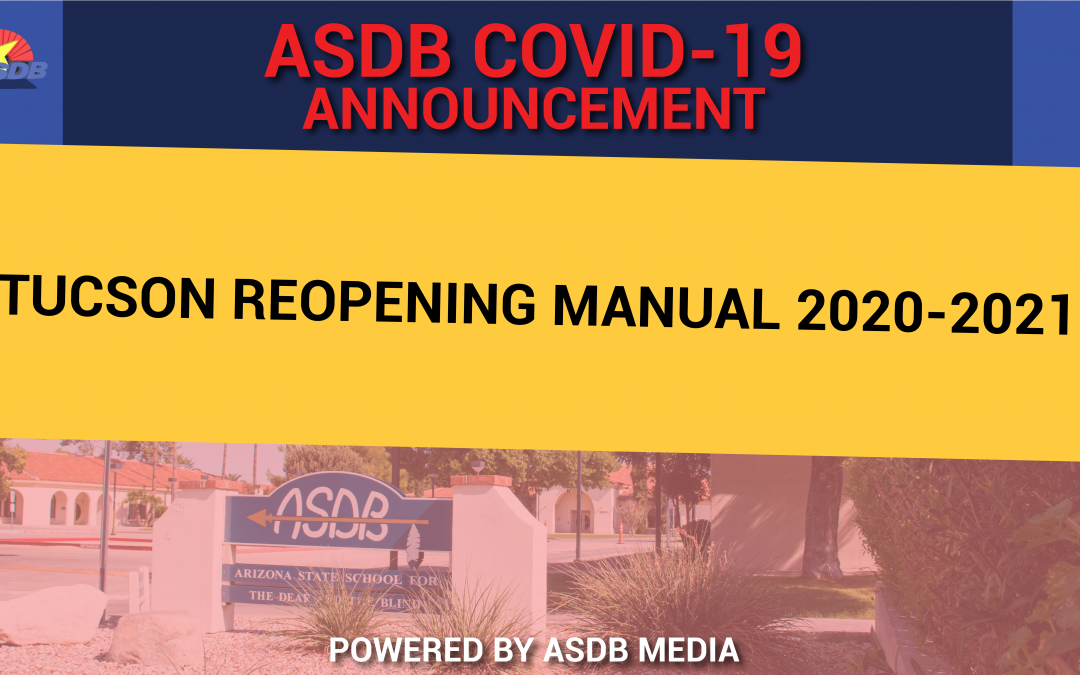
Tucson reopening manual 2020-2021

PDSD reopening manual 2020-2021

Flu Recommendations
From the University of Arizona
Information You Need: Get your flu shot!
We are entering the 2020-2021 flu season in the midst of a pandemic and it is more important than ever to receive a flu vaccine. Here are just a few reasons:
- In Arizona, over 4,000 people are hospitalized for complications from the flu each year. Therefore, hospitalized flu cases added to the number of hospitalized COVID-19 cases will further stress an already overwhelmed healthcare system.
- If someone were to be hospitalized for the flu, their risk of developing COVID-19 would increase as they would be in a high-risk healthcare setting.
- Experts are unsure exactly how a simultaneous infection of the flu and COVID-19 would affect the body.
- Flu symptoms can be very similar to symptoms of COVID-19, as they are both respiratory viruses. So the medical equipment needed to assist severe cases (e.g., supplemental oxygen, ventilators) would also be similar and could exacerbate medical equipment shortages.
| Who SHOULD get the flu vaccine? |
| Anyone over the age of 6 months should receive a flu vaccine including: – Pregnant women – Older adults over 65 years of age should consider getting the “High Dose” version of the vaccine, talk to your provider for more information – Individuals with chronic medical conditions – Health care workers and their families |
| Who should talk to their healthcare provider BEFORE getting the flu vaccine? |
| – Children younger than 6 months old – Individuals with a severe chicken egg allergy (those with mild chicken egg allergies should check with their physician), there may be an alternative vaccine for those who have an allergy – Individuals who have had a severe reaction to the flu vaccine in the past – Those with a current illness accompanied by a fever should wait until the fever and other symptoms subside to get a flu vaccine |
| Where can I get a flu shot? |
| To locate a flu shot clinic near you: – Contact your primary care provider as they may have vaccines available at their practice – Contact your insurance company to find out if there are any in-network clinic preferences – Visit the “Stop the Spread AZ” website – Dial 211 in Arizona (call 1-877-211-8661 if outside of Arizona) – Call your local pharmacy or grocery store to see if they offer flu shots, you may also visit their websites to find out more information, locations, or to make an appointment |
| When going to receive a flu shot, it is especially important to: |
| – Take COVID-19 safety precautions including: wearing a cloth face covering, maintaining physical distancing, and avoiding crowded, poorly ventilated spaces – Be sure to take your temperature before going to receive a flu shot. If you have a temperature over 100, wait until your fever subsides before getting the vaccine |
| Frequently Asked Question: Can the flu shot give me the flu? |
| Perhaps one of the biggest misconceptions surrounding the flu shot is that getting the vaccine can “give you flu.” In fact, the flu virus is “inactive” which means that the virus particles are dead and thus cannot spread the virus. Some may feel mild symptoms after receiving the vaccine because their body is developing the antibodies needed to protect them from the flu. |
| Visit this link for more information about getting the flu vaccine. |
Information provided by The University of Arizona at: https://azcovidtxt.org/2020/09/01/updates-august-31/
From the CDC
This Season a Flu Vaccine is More Important than Ever!
Getting a flu vaccine is more important than ever during 2020-2021 to protect yourself, your family and your community from flu. A flu vaccine this season can also help reduce the burden on our healthcare systems responding to the COVID-19 pandemic and save medical resources for care of COVID-19 patients.
The more people vaccinated; the more people protected. Do your part. Get a flu vaccine this fall.
What to expect for the 2020-2021 flu season, during the COVID-19 Pandemic?
The Difference between Flu and COVID-19
What You Need to Know for 2020-21 Flu Season
Protect Yourself and Others from COVID-19
Information for Health Care Professionals 2020-2021 Flu Season
Information provided by the CDC : https://www.cdc.gov/flu/season/protect-your-health.html
From the Arizona Department of Health Services
Vaccine
Preventing the Flu: Get Vaccinated!
The single best way to prevent the flu is to get a flu vaccination every year. There are two types of vaccines:
- The “flu shot” – an inactivated vaccine (containing killed virus) that is given with a needle. The flu shot is approved for use in people 6 months of age and older, including healthy people and people with chronic medical conditions.
About two weeks after vaccination, antibodies develop that protect against influenza virus infection. Flu vaccines will not protect against flu-like illnesses caused by non-influenza viruses.
When to Get Vaccinated
Everyone should get vaccinated as soon as the flu vaccine becomes available each year. However, it is still beneficial for anyone who was not vaccinated in early fall to get vaccinated later in the fall or winter because most influenza activity typically occurs in January or later. Though it varies, flu season can last as late as May so it is never too late to get vaccinated.
Who Should Get Vaccinated?
Everyone 6 months and older should be vaccinated every year. Even healthy people should get vaccinated because they could spread the flu to someone who is at high risk for complications from the flu or who is not able to get a flu vaccine.
Where to Get Vaccinated?
- Visit Vaccine Finder to find a flu shot clinic near you.
Flu Vaccination is especially important for:
- People at high risk for complications from the flu, including:
- Children aged 6 months or older,
- Pregnant women,
- People 50 years of age and older,
- People of any age with certain chronic medical conditions, and
- People who live in nursing homes and other long term care facilities.
- People who live with or care for those at high risk for complications from flu, including:
- Health care workers
- Household contacts of persons at high risk for complications from the flu (see above)
- Household contacts and out of home caregivers of children less than 6 months of age (these children are too young to be vaccinated)
- Anyone who wants to decrease his or her risk of getting or spreading influenza.
Who Should Not Be Vaccinated
Some people should not be vaccinated without first consulting a physician. They include:
- People who have a severe allergy to chicken eggs. People with mild allergic reactions (hives) should still be vaccinated.
- People who have had a severe reaction to an influenza vaccination in the past.
- People who developed Guillain-Barré syndrome within 6 weeks of getting an influenza vaccine previously.
- Children less than 6 months of age (influenza vaccine is not approved for use in this age group).
- People who have a moderate or severe illness with a fever should wait to get vaccinated until their symptoms lessen.
If you have questions about whether you should get a flu vaccine, consult your healthcare provider.
Information provided by the Arizona Department of Health Services: https://www.azdhs.gov/preparedness/epidemiology-disease-control/flu/index.php#vaccine
From the CDC Regarding Immunization Recommendation
A CDC report released in May 2020 found a troubling drop in routine childhood vaccinations as a result of families staying at home. While families followed public health warnings about going out, an unfortunate result was many missed routine vaccinations. CDC and the American Academy of Pediatrics (AAP) recommend every child continues to receive routine vaccinations during the COVID-19 outbreak.
Well-Child Visits and Vaccinations Are Essential Services
Children need to be protected against vaccine-preventable diseases. Well-child visits and vaccinations are essential services and help make sure children are protected. Children who are not protected by vaccines may be more likely to get diseases like measles and whooping cough.
As communities are opening up, it’s important for parents to work with their children’s doctor or nurse to make sure their children stay up to date on routine vaccines.
Information provided by the CDC: https://www.cdc.gov/vaccines/parents/visit/vaccination-during-COVID-19.html
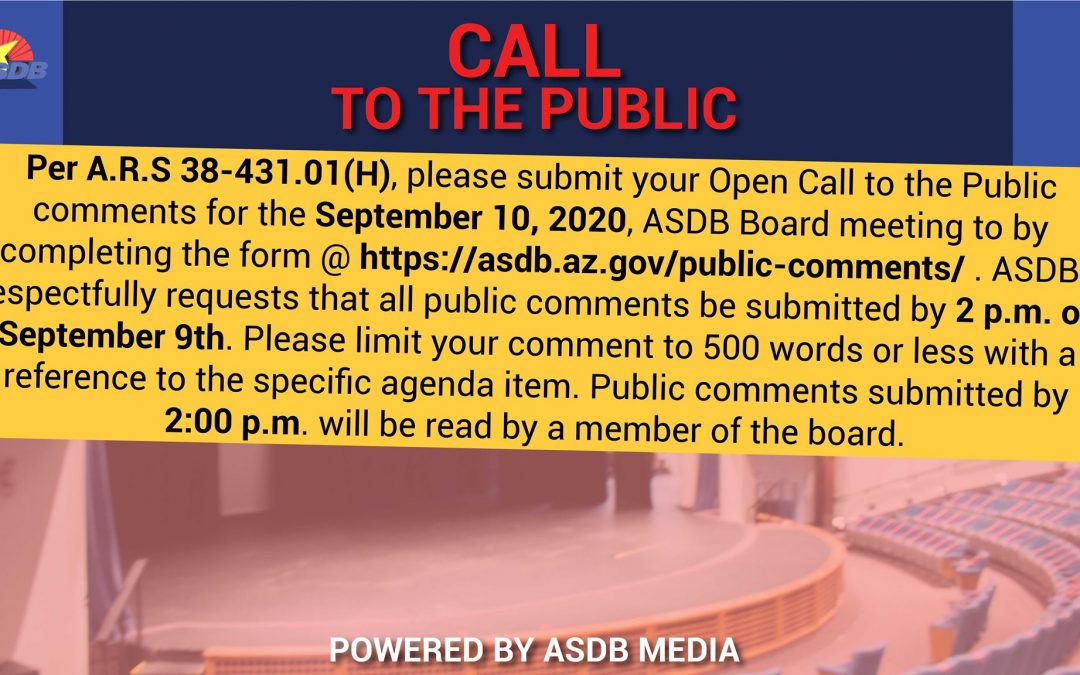
Call to Public
CALL TO THE PUBLIC:Per A.R.S 38-431.01(H), please submit your Open Call to the Public comments for the September 10, 2020, ASDB Board meeting by completing the form @ https://asdb.az.gov/public-comments/ . ASDB respectfully requests that all public comments be submitted by 2 p.m. on September 9th. Please limit your comment to 500 words or less with a reference to the specific agenda item. Public comments submitted by 2:00 p.m. on September 9th will be read by a member of the board at the September 10, 2020, ASDB Board meeting.
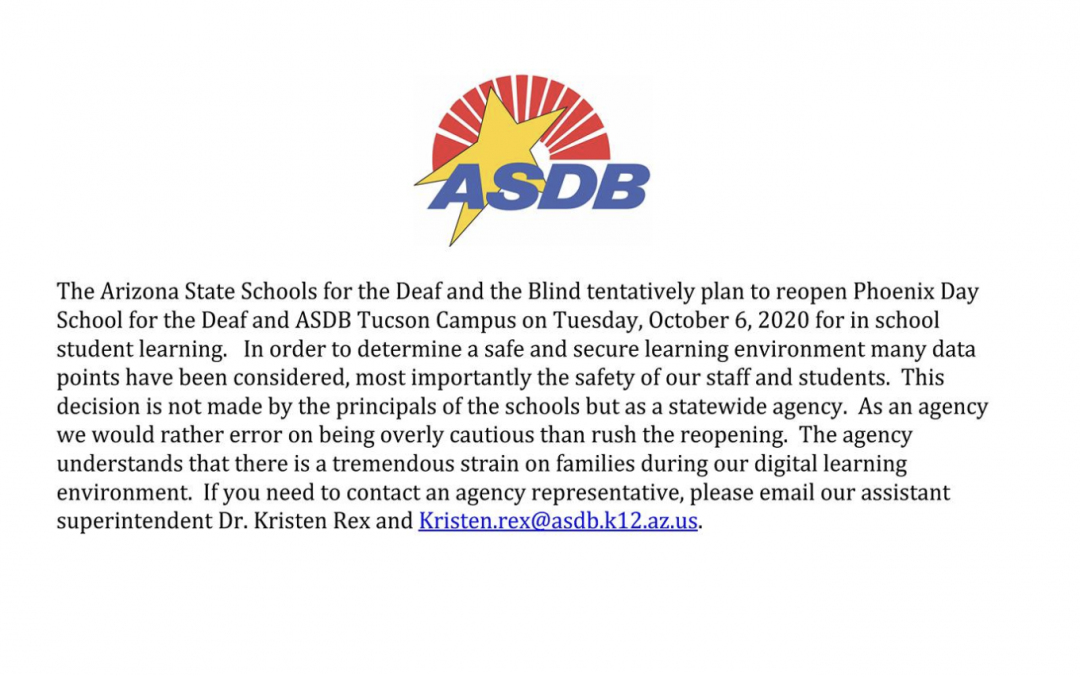
COVID-19 UPDATE: In-Person Learning
A message from Superintendent Annette Reichman and Assistant Superintendent Kristen Rex:The Arizona State Schools for the Deaf and the Blind tentatively plan to reopen Phoenix Day School for the Deaf and ASDB Tucson Campus on Tuesday, October 6, 2020, for in-school student learning. In order to determine a safe and secure learning environment, many data points have been considered, most importantly the safety of our staff and students. This decision is not made by the principals of the schools but as a statewide agency. As an agency, we would rather error on being overly cautious than rush the reopening. The agency understands that there is a tremendous strain on families during our digital learning environment.If you need to contact an agency representative, please email our assistant superintendent Dr. Kristen Rex and .
Los Arizona State Schools for the Deaf and the Blind tentativamente planifican reabrir el Phoenix Day School for the Deaf y el recinto escolar ASDB de Tucson el martes 6 de octubre del 2020 para el aprendizaje de los estudiantes en la escuela. Para poder determinar un entorno de aprendizaje seguro y protegido, se han considerado muchos puntos de datos, lo más importante es la seguridad de nuestro personal y estudiantes. Esta decisión no la toman los directores de las escuelas, sino una agencia estatal. Como agencia, preferimos equivocarnos al ser demasiado cautelosos que apresurar la reapertura. La agencia comprende que existe un tremendo estrés sobre las familias durante nuestro entorno de aprendizaje digital. Si necesita comunicarse con un representante de la agencia, envíe un correo electrónico a nuestra superintendente asistente, la Dra. Kristen Rex y .
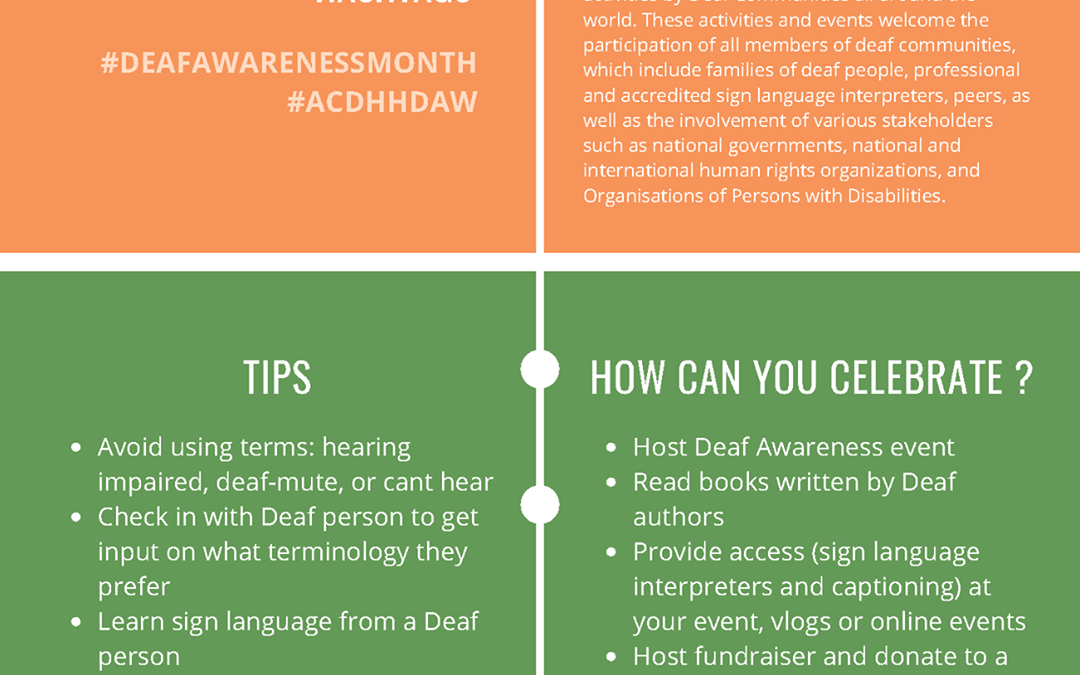
International Deaf Awareness Month
Celebrating International Deaf Awareness Month is a great way to connect with each other online. Let’s continue to be #TogetherApart!#ACDHHDAW #DeafAwarenessMonth
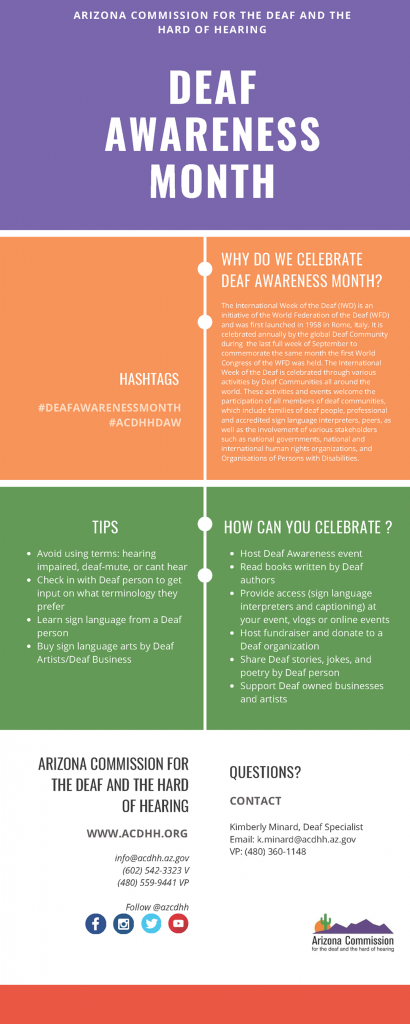

Arizona State Schools For The Deaf And The Blind Adapt To Online Learning
By Katie CampbellPublished: Monday, August 24, 2020 – 5:05amUpdated: Monday, August 24, 2020 – 7:52am
Students across the state are adapting — or at least trying to adapt — to online learning, while others return to classrooms.
The Arizona State Schools for the Deaf and the Blind welcomed some students back last week. But many students with visual and hearing impairments are learning to navigate their worlds from home.
Students and staff who had hoped to return to classrooms are instead learning from home — and they want desperately to be back.
“We’re all longing for that day when we can see the faces and hear those voices and see those smiles,” says Kelly Creasy, the principal at the ASDB Tucson campus.
In June, she was optimistic, planning to have students return to campus this month. She explained how her relatively small batch of students — less than 200 each year — made it easier to ensure kids would be safe.
But so much has changed since June. The state released guidelines and a three-part test for reopening. According to that test, her students can’t come back just yet.
School leaders can still choose to reopen despite the state’s recommended metrics, and some have. But not Creasy — not entirely anyway.
Usually, about 40 students actually live at her Tucson campus. Unlike other schools in the area, Creasy’s serves students from every corner of the state, from Tuba City to Nogales and everywhere in between.
Families were given the option to return if they lacked access to vital internet service at home. Fifteen students returned.
“Being here is going to be a little different,” Creasy says. “We have them clustered into their dorms. So, essentially, we’re creating our own bubbles for each of the groups. So, we’ll use four dorms, and they’ll just stay within their dorm. Staff will just be assigned to that dorm to work, so that we keep it as safe as possible.”
And visually impaired students will learn how to keep a safe distance from their friends and teachers, even if they can’t see them.
“One of the things we talked about with our visually impaired students is what is six feet,” Creasy explains. “And so, we talked about getting a mop or a broom that you have in your home and holding one end and having a family member on the other — that’s about six feet. So, hearing what that voice sounds like as it gets closer to you.”
The rest of Creasy’s students received laptops, braille tools, even Wi-Fi hotspots if they were requested.
Creasy said buses loaded with more than 100 kits were sent out across the state, an effort that cost more than $100,000. About $60,000 of that sum came from CARES Act funding.
Amelie Morales has been receiving materials from her teacher at the Phoenix Day School for the Deaf all summer. She started class online last week. It helps that she knows — and rather likes — her teacher, Stephanie Voss. Even if the connection isn’t perfect on Zoom.
Amelie’s mom, Laura Morales, says something is clicking for her daughter despite the challenges of learning from home.
“A lightbulb just went off, and she’s just been blowing up in language,” Morales says of Amelie. “I’ve always signed to Amelie, and it’s just like — she’s signing so much. And I’m just like, ‘Whoa. Where did that come from?'”
Not every ASDB student has a parent who can use ASL, like Morales, or a family that is totally comfortable with letting visually impaired students get around on their own.
Some have been deeply affected by the pandemic, both in terms of accessibility and emotionally. Creasy says some lost loved ones or members of their communities.
“Some of them are coming back from reservations and feel like this may be a safer place right now,” she says. “And, you know, that first couple of weeks or so — everybody, whether they’re here on campus or we’re seeing them via Zoom, we’re going to be really paying attention to how they’re doing and what other supports can we provide to that student and their family.”
And so much of that falls to the teachers.
“We threw together materials and tried to get those into the hands of families,” says Stephanie Voss, Amelie’s teacher. “And then, we just had to try and take what we usually do and figure out how that could be done on Zoom in a way that was meaningful still for young students.”
Voss sent Amelie and her five other deaf students activity packets to keep them learning after schools shut down. But these are key years for them to develop language skills, and she’s worried.
“With 3- and 4-year-old deaf children, sitting in front of a computer is not the best way to learn,” Voss explains. “We have such a limited time for all students to gain language, so it’s very stressful for me to think that one whole year of their early childhood language development years could be online.”
For now, the school year is not what everyone was hoping for. But they’re trying.
And parents like Morales are finding hope in their children. She once felt inadequate for her daughter. The pandemic and her daughter’s growth despite it has shown her otherwise.
“I can finally say I am good enough, you know?” Morales says. “I can finally say I believe in myself. I think I am capable. I can do this.”
